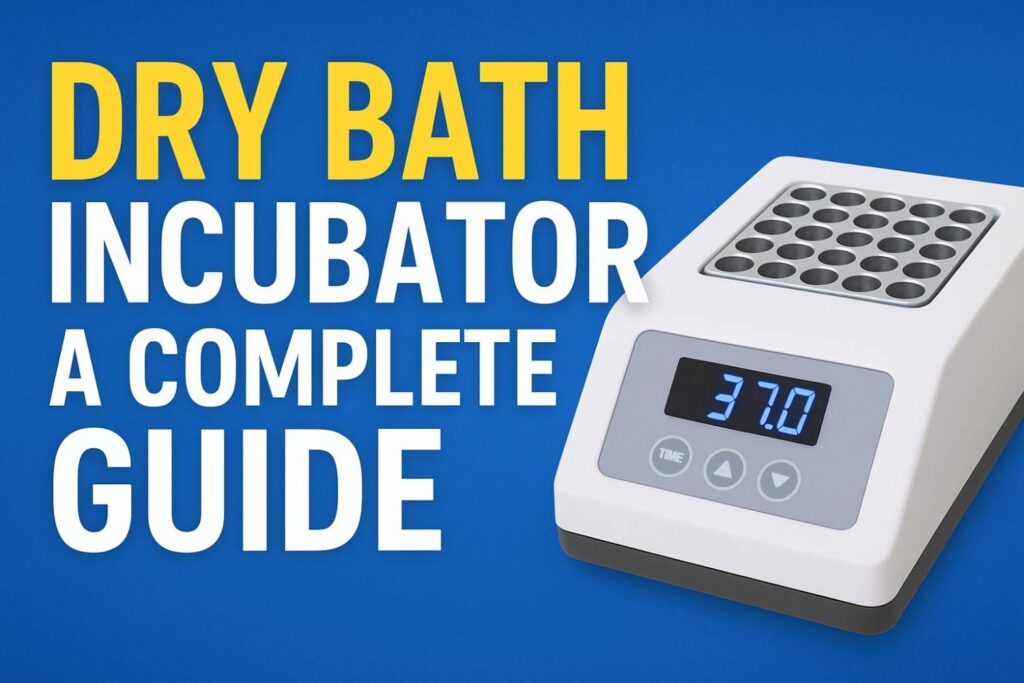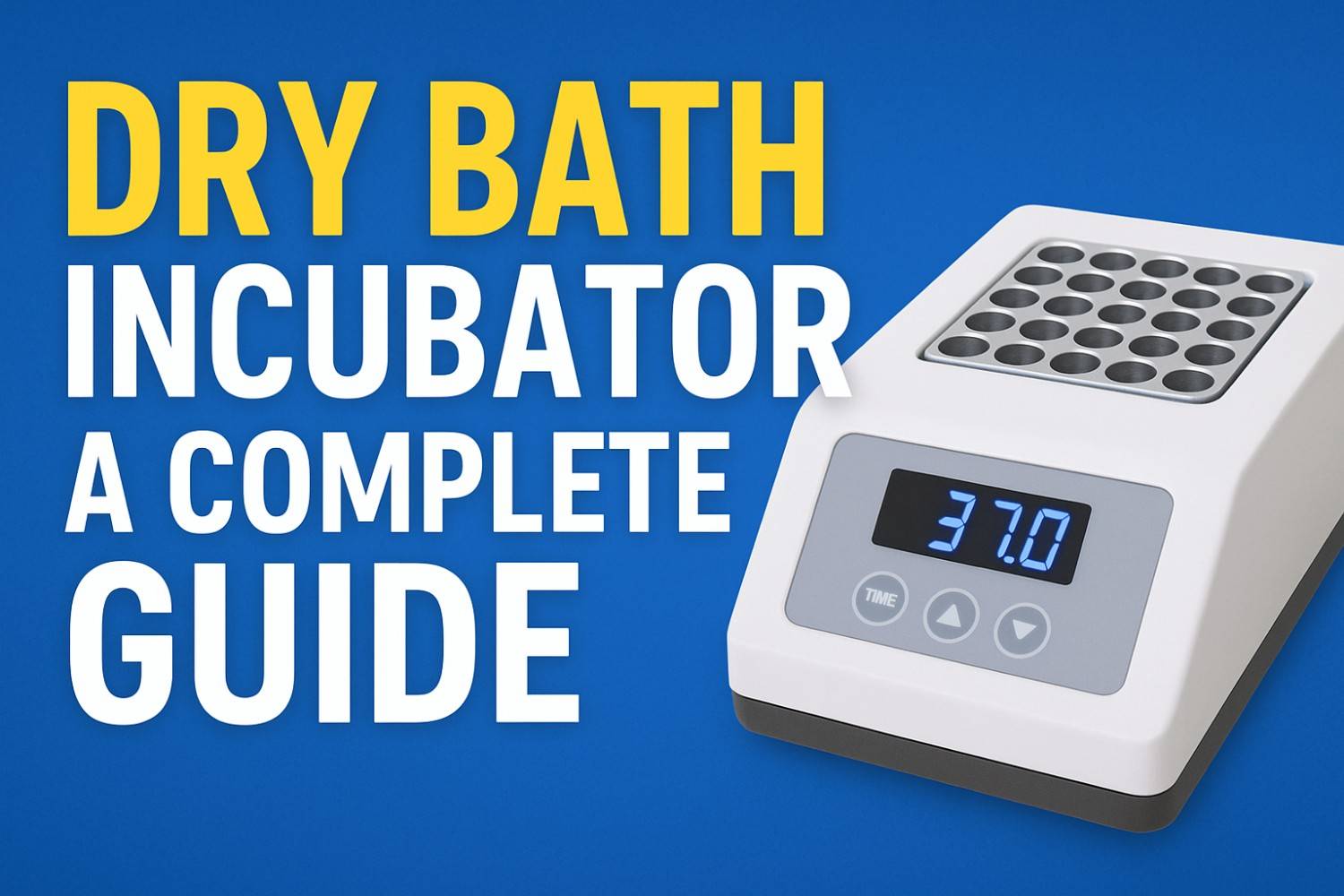
Table of Contents
ToggleDry Bath Incubator : A Complete Guide
In the current rapid-paced settings of biomedical research and diagnostics, precision and reliability are paramount. A vital instrument found in every laboratory is the Dry Bath Incubator, a compact and efficient device engineered for accurate temperature regulation during sample incubation. In contrast to conventional water baths, a dry bath incubator utilizes solid heat blocks to sustain temperature, offering a cleaner, safer, and more convenient alternative.
This article covers everything you need to understand — from its operational mechanisms to its practical uses, advantages, and purchasing guide.
A Dry Bath Incubator: What Is It?
A Dry Bath Incubator, sometimes referred to as a block heater or dry block incubator, is a type of laboratory apparatus that uses an aluminum block to uniformly heat samples put in test tubes, microtubes, or vials.
Depending on the size of the tube, these blocks can be switched out and are thermally conductive.
Crucial Role
It ensures sample integrity during enzymatic experiments, DNA denaturation, coagulation investigations, and more by maintaining a constant temperature between ambient +5°C to about 150°C (depending on the model).
The Dry Bath Incubator’s Operation
The dry bath incubator uses a straightforward yet accurate heating mechanism:
- Heating Component: The metal block is uniformly warmed by electric heaters.
- Thermostatic Control: The temperature is managed using an analog or digital thermostat.
- Feedback Sensor: To prevent overheating, built-in sensors continuously check the block’s temperature.
- Even Heat Distribution: Every tube well has the same temperature thanks to the metal block.
For accurate and real-time monitoring, contemporary dry bath incubators frequently use digital LCD screens and microprocessor-based controllers.
Important Characteristics of a Dry Bath Incubator Include
- Interchangeable blocks for different tube sizes (0.2 mL, 1.5 mL, 15 mL, etc.)
- High-precision sensors are used in digital temperature control.
- Quick Heating: Quickly reaches the desired temperature.
- Timer Function: Enables shutdown automatically after a predetermined amount of time.
- Over-temperature Protection: Guarantees the security of both the sample and the user.
- Bench space is saved because to the compact design.
- Low Maintenance: Cleaning issues and pollution are avoided when there is no water.
Types of Dry Bath Incubators
| Type | Description | Ideal For |
|---|---|---|
| Single Block Dry Bath | One aluminum block, suitable for small labs | Basic biochemical reactions |
| Double Block Dry Bath | Two independent blocks with separate controls | Parallel experiments |
| Dual Temperature Dry Bath | Two temperature zones for multitasking | Molecular biology labs |
| Programmable Dry Bath | Advanced models with memory and ramping functions | Research and high-end diagnostics |
Dry Bath Incubator Applications
Biomedical, clinical, pharmaceutical, and industrial laboratories all employ dry bath incubators.
Typical Uses:
- Denaturation of DNA and RNA
- Reactions and inactivation of enzymes
- Tests for coagulation and serology
- Digestion and incubation of proteins
- Electrophoresis sample preparation
- PCR procedures and ELISA tests
- Incubation of microbial and biochemical samples
Benefits of Using a Dry Bath Incubator
- No Need for Water: removes maintenance problems and pollution.
- Accurate Temperature Control: Perfect for delicate biological processes.
- Safe and Clean Operation: There is no chance of water evaporating or spilling.
- Compact and Portable: It fits on lab benches with ease.
- Energy Efficient: Consumes less electricity than water baths.
- Adaptable Use: Fits a range of sample kinds and tube sizes.
Dry Bath Incubators’ Drawbacks
Dry bath incubators are quite effective, but they have several drawbacks:
- They can’t create the humid conditions needed for particular cell cultures.
- Compared to huge water baths, the capacity is limited.
- Needs to be compatible with different types of tubes.
How to Pick the Best Dry Bath Incubator
Take into account the following when buying a dry bath incubator for your lab:
🔧 Technical Parameters
- Range of Temperatures: should satisfy your needs for experimentation.
- The optimal temperature accuracy is between ±0.1°C and ±0.5°C.
- Block Type & Capacity: Comply with the dimensions of your test tubes.
- Heating Speed: Workflow efficiency is enhanced by faster heating.
- Display & Controls: Select versions that have digital timer and temperature displays.
Considerations for Users
- Lab Size: Small models for compact configurations.
- Applications: Depending on workload, choose between single and dual block models.
- Brand Reliability: Choose well-known manufacturers that provide calibration assistance and warranties.
Maintenance Advice for Extended Life
- Use alcohol wipes to clean the aluminum block on a regular basis to ensure optimal functioning.
- Don’t force or overload tubes.
- After extended use, let the electricity cool down before shutting it off.
- To ensure accuracy, periodically check the temperature.
- To avoid overheating, keep the vents open.
FAQs (Frequently Asked Questions)
1. What distinguishes a water bath incubator from a dry bath incubator?
A water bath employs heated water, but a dry bath uses a solid heating block to regulate the temperature. Water baths offer humid conditions, while dry baths are safer and cleaner.
2. Can PCR tubes be incubated in a dry bath?
Indeed, the majority of dry bath incubators include interchangeable blocks that fit vials, PCR tubes, and microcentrifuge tubes.
3. What range of temperatures is available in a dry bath incubator?
Depending on the model, it usually ranges between ambient +5°C to 150°C.
4. Is calibration required?
Indeed, calibration guarantees temperature precision, particularly in delicate investigations such as enzyme reactions.
5. How long can samples be kept in an incubator with a dry bath?
Depending on the specifications of the process, samples may stay for a few minutes to several hours.
In Conclusion
A key component of contemporary laboratory procedures is the Dry Bath Incubator. It has become essential for biochemistry, research, and diagnostics due to its clean operation, precision heating, and dependability.
Investing in a quality dry bath incubator improves productivity and accuracy, ensuring that your studies run smoothly and effectively regardless of the size of your lab.
Notice
This article’s content is solely meant to be instructive and informative. It should not be used in place of product instructions or expert laboratory guidelines. Before operating any equipment, always consult the approved handbook and safety procedures.




